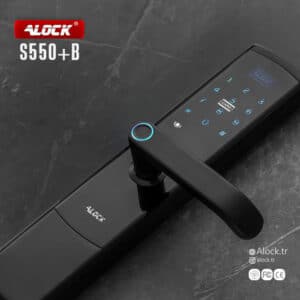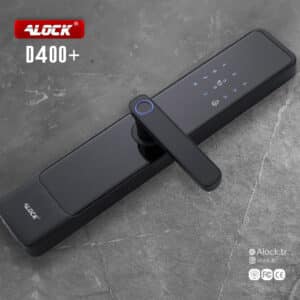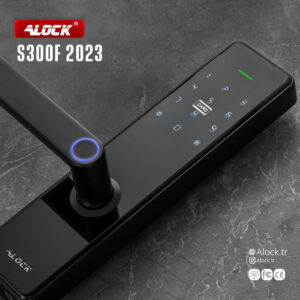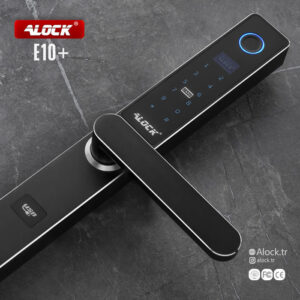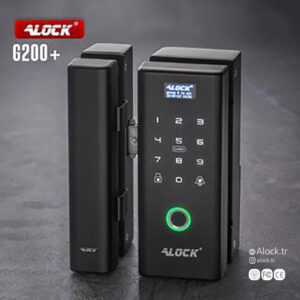Fingerprint Door Lock
ALOCK Fingerprint Lock
ALOCK Digital Lock Company is one of the leading manufacturers in the field of fingerprint locks. All of its fingerprint door handles are equipped with Swedish 360° biometric scanners. These products are exceptionally sensitive, capable of storing over 1,200 fingerprint profiles per unit. The biometric scanners used in ALOCK’s devices are sourced from FTP Sweden, one of the world’s most renowned fingerprint technology brands.
Every smart lock model developed by ALOCK not only features advanced biometric fingerprint recognition but also incorporates two-factor authentication (2FA), delivering the highest level of security for users.
Everything You Need to Know About Fingerprint Door Handles and Locks
A fingerprint door handle and lock is a type of digital lock that uses fingerprint recognition to unlock the door. It offers a highly secure solution, as every individual’s fingerprint is unique and cannot be easily duplicated or forged. These locks provide a convenient and safe way to open and close doors. They eliminate the need for traditional keys and can store multiple users’ fingerprints for access.
How a Fingerprint Door Lock Works
A fingerprint door lock uses a fingerprint scanner to identify users. The scanner is typically installed on the handle or directly on the door. When a user places their finger on the scanner, it reads the fingerprint and compares it to the stored fingerprint data in the lock’s memory. If there is a match, the door unlocks.
These scanners generally fall into two main categories: thermal and optical. Thermal scanners detect fingerprints by measuring temperature differences across various parts of the finger. Optical scanners, on the other hand, use light to capture and analyze the fingerprint’s unique patterns.
Anti-Theft Fingerprint Door Handle
An anti-theft fingerprint door handle is a type of digital handle that uses fingerprint recognition to unlock the door. These products have gained significant popularity in recent years due to their high level of security. Anti-theft fingerprint handles offer several advanced features that make them more secure than traditional locks. These features include:
Multi-User Recognition: Anti-theft fingerprint handles can recognize multiple users’ fingerprints, making them ideal for households where several individuals need access.
Anti-Spoofing Technology: These handles are equipped with sophisticated technology to detect fake fingerprints and distinguish them from real ones, effectively preventing forgery.
Intrusion Resistance: These handles come with additional safety features such as mechanical key overrides and intrusion alarms, offering protection against both physical and electronic break-in attempts.
Compared to traditional locks, anti-theft fingerprint handles provide numerous advantages. They are safer, more convenient, and highly reliable. If you’re looking to enhance the security of your home or workplace and the cost of a fingerprint handle aligns with your budget, purchasing one is an excellent choice.
Advantages of Fingerprint Door Locks
Some of the key benefits of fingerprint door locks include:
Enhanced Security: Since every fingerprint is unique and difficult to duplicate or forge, these locks offer a secure solution for both residential and commercial settings.
Convenience: Fingerprint locks eliminate the need for keys, making door access faster and more effortless.
Programmable Access: These locks can be configured to store multiple users and manage various access permissions, which is especially useful for families with children or businesses with multiple employees.
Ease of Use: Fingerprint locks are user-friendly—there’s no need to remember or input complex passwords. Simply place your finger on the sensor to unlock the door instantly.
Improved Access Tracking: These systems allow you to control and restrict access by only authorizing registered fingerprints, enhancing your ability to monitor and manage entry.
Durability: Fingerprint locks are built to withstand exposure to water, dust, and dry environments, making them suitable for a wide range of conditions and workplace environments.
Types of Fingerprint Door Locks
Fingerprint door locks are available in a variety of models, each designed to meet specific needs. Some of the most common types include:
Single-User Fingerprint Locks: Designed for use by a single authorized user only.
Multi-User Fingerprint Locks: These models support access for multiple authorized users.
Touchscreen Fingerprint Locks: Equipped with a touch panel where users can place their fingerprints.
Wireless Fingerprint Locks: These models connect to smartphones or other smart devices via Bluetooth or Wi-Fi.
Fingerprint locks can also be categorized based on the type of scanner, installation method, and additional features.
Based on Scanner Type: Modern fingerprint locks typically use one of the following two types of fingerprint scanners:
Optical Scanners: These use LED light to illuminate the fingerprint and a built-in camera to capture the image. Optical scanners are generally more affordable but offer lower accuracy.
Thermal Scanners: These utilize a thermal sensor to detect the heat patterns of a fingerprint. They are more accurate than optical scanners, though usually more expensive.
Based on Installation Method: Fingerprint locks are commonly divided into two main categories depending on how they are installed:
- Mortise (Built-in) Locks: These are installed within the door itself. Mortise locks offer higher security since they are harder to tamper with.
- Surface-Mounted Locks: These are installed on the surface of the door and are easier to install, though they may not be as secure as built-in models.
Based on Additional Features: Many fingerprint locks come with extra functionalities, such as:
Smart Card Support
- Password or PIN Code Entry
- Mechanical Key Backup
Tips for Choosing and Buying a Fingerprint Door Lock
When selecting a fingerprint lock, it’s important to consider several key factors:
- Required Security Level: For high-security needs, choose a lock with advanced features like 3D fingerprint scanning or facial recognition.
- Number of Authorized Users: If multiple people need access, opt for a multi-user fingerprint lock.
- Type of Door: Fingerprint locks are available for various types of doors, including wooden, metal, and glass doors.
- Lock Type: Choose from a variety of handle designs based on your specific requirements.
- Build Quality: A well-built product will last longer and perform more reliably.
- Features: Locks with advanced features—such as online access and remote management—offer greater flexibility and security.
- Price: Fingerprint locks come in a wide range of prices. Higher-end models typically offer better build quality and more features.
Installing a Fingerprint Door Lock
Installing this type of security system is typically carried out by a professional. However, some fingerprint locks come with easy-to-follow installation guides, allowing for DIY installation. The process is relatively straightforward and can usually be completed within a few hours.
Materials and Tools Required:
- Standard door lock set
- Screwdriver
- Measuring tape
- Pencil
Installation Steps:
Determine the Lock Placement
Choose a location for the lock that is easily accessible but protected from direct exposure to rain or snow.
- Measure the Installation Area
Ensure that the lock fits precisely in the selected location by measuring the dimensions accurately.
- Drill Mounting Holes
Use a drill to create holes of appropriate size for the lock screws.
- Mount the Lock
Position the lock in place and secure it using a screwdriver.
- Configure the Lock
Follow the manufacturer’s instructions to complete the lock configuration.
Lock Configuration Steps:
- Register Your Fingerprint
Place your finger on the lock’s sensor. You may need to scan it from multiple angles to ensure a complete registration.
- Add Additional Users
If other individuals also need access, you can register their fingerprints as well.
- Adjust Lock Settings
Customize settings such as alarm alerts, auto-lock timing, and other preferences according to your needs.
Safety Tips
- Ensure you have the appropriate tools before beginning installation.
- Avoid drilling holes deeper than necessary.
- Secure the lock firmly to prevent it from coming loose.
- Regularly update your fingerprint registration for optimal recognition.
Fingerprint Gate Locks
Fingerprint locks designed for gates typically include the following features:
- Fingerprint Sensor
Authenticates authorized users and unlocks the gate.
- Keypad
Allows password or access code entry as an alternative method.
- Display Screen
Shows important information such as date and time, lock status, and error messages.
- Additional Features
Some models offer extra functionality such as child lock, tamper alarms, smart card support, and online connectivity for remote access.
Advantages of Fingerprint Gate Handles Compared to Traditional Locks:
- Higher Security
Fingerprints are unique biometric identifiers and difficult to replicate.
- Greater Convenience
No need to carry physical keys to unlock the gate.
- Programmability
Can be configured to allow access for multiple authorized users.
Fingerprint gate handles can be an excellent investment for any home or business. They offer a combination of enhanced security and user convenience, helping to safeguard your property and assets.
How a Fingerprint Gate Lock Works:
- The user places their finger on the sensor.
- The sensor scans the unique fingerprint patterns.
- If the scanned pattern matches a registered fingerprint in the system’s memory, the lock opens.
Fingerprint Door Lock for Apartments
To use a fingerprint lock on an apartment door, the fingerprints of authorized individuals must first be registered in the lock’s memory. This is done by placing the user’s finger on the scanner and pressing the registration button. The lock then records the fingerprint pattern. Below are some of the key advantages of using a fingerprint door lock for apartments:
- High Security
Each fingerprint has a unique pattern that is nearly impossible to duplicate, making fingerprint locks an extremely secure option.
- Ease of Use
Unlocking the door is as simple as placing your finger on the scanner, offering quick and effortless access.
- Versatility
These locks often support multiple unlocking methods. In addition to fingerprint recognition, they may also be operated via password, smart card, or mechanical key. This flexibility makes them ideal for users with physical limitations or those who prefer multiple access options. ALOCK offers a range of keypad-enabled handles—visit the dedicated page for more information.
- Durability
Fingerprint locks are typically made from high-quality materials and are resistant to environmental factors, ensuring long-term performance.
Using a fingerprint lock on your apartment door is an excellent security upgrade, offering robust protection, ease of access, and versatile features.
Fingerprint Lock Pricing
The price of a fingerprint lock depends on several factors, including:
- Lock type
- Brand
- Build quality
- Additional features
Generally, fingerprint lock prices start from around 100,000 tomans and can go up to several million tomans. Lower-priced models are usually made from cheaper materials and offer basic functionality—suitable for home use and light-duty applications. On the other hand, high-end models are built from premium materials and include advanced features, making them more suitable for commercial or industrial use.
Prices also vary between retailers. Online stores often provide more competitive pricing than physical outlets.
Key factors to consider when purchasing a fingerprint lock:
- Lock Type
Basic locks rely solely on fingerprint access. More advanced models may offer features like live-fingerprint detection, multi-user recognition, and tamper alerts.
- Brand
Some brands have a stronger reputation and longer track records. For example, August is an emerging brand that offers smart fingerprint locks controllable via a mobile app and integrable with devices like Amazon Alexa and Google Home.
- Features
More features typically mean a higher price. For example, an online password-protected lock provides enhanced security for sensitive data by requiring a strong password composed of letters, numbers, and symbols.
- Budget Planning
Determine your budget before making a purchase decision.
What Is a Fingerprint?
A fingerprint is composed of tiny ridges (visible to the naked eye) found on the epidermal layer of the palms and soles. In simple terms, they are the grooved patterns on your fingertips. These ridges are unique to each individual and cannot be replicated, not even between identical twins (monozygotic). Statistically, the probability of two individuals having identical fingerprints is approximately 1 in 64 billion.
Biometric Identification Using Fingerprints
Because fingerprints are unique and remain unchanged throughout a person’s lifetime, they serve as a highly reliable method for identity verification.
Due to the presence of natural oils in the skin, fingerprints leave marks on smooth surfaces. These marks can be made more visible by applying powders that adhere to the oils. Fingerprint formation is influenced by both genetic and environmental factors—everything from prenatal stress to umbilical cord length can affect ridge development. Once formed, usually shortly after birth, fingerprints are permanent.
Using Fingerprints in Digital Lock Technology
Thanks to these unique biometric traits, scientists have developed identity verification systems based on fingerprint recognition. These systems are equipped with sensors that read the ridges on a finger, compare them to stored data in a database, and either confirm or deny access.
One of the most practical applications of this technology is the fingerprint door handle. In the 21st century, fingerprint locks have gained widespread popularity and are considered one of the most secure and efficient access control methods. They are especially favored in residential buildings, office spaces, server rooms, and other high-security environments due to their speed, precision, and reliability in authenticating users.
Types of Fingerprint Scanners in Digital Door Locks
Optical Scanner in Fingerprint Door Handles
Some fingerprint door locks are equipped with optical scanners. In these models, a light-emitting diode (LED) is positioned beneath the scanner surface. When a fingerprint is placed on the scanner’s touchpad, the image of the fingerprint is captured and transmitted as a visual representation to the lock’s data center for comparison and verification.
Biometric Scanners in Fingerprint Door Locks
Other models are equipped with biometric scanners that are highly sensitive to the presence of a fingerprint. Biometrics refers to the measurement and analysis of physical and behavioral characteristics. Biometric scanners are designed to verify and identify individuals using data such as fingerprints, voice, facial features, and more. Devices that operate with biometric technology offer significantly faster identity verification compared to conventional methods.
In these types of scanners, a fine metallic strip is embedded around the sensor area. This strip detects the static electricity naturally present on the human body. As soon as a finger touches the sensor, the scanner automatically exits standby mode and activates. The touch-sensitive surface then analyzes the fingerprint ridges and transmits the data to its internal database for authentication.
Biometric Sensors in Fingerprint Door Locks
Some advanced systems feature biometric sensors that go beyond static electricity detection. These sensors can also detect body heat, thereby preventing unauthorized access through the use of fake fingerprints. In such devices, fingerprint data is stored in the form of encrypted binary code (0s and 1s).
This encryption process follows a method commonly referred to as the Hash Protocol. Even if someone gains unauthorized access to the system’s database, it would be impossible to extract or reverse-engineer individual fingerprint images or personal information. This ensures the device maintains the highest level of security.
Sensor Placement in Digital Door Handles
Manufacturers place fingerprint sensors in different locations on digital door handles. Some models position the sensor above or below the handle, while others integrate it directly onto the handle itself. Scanners embedded in the handle are designed according to ergonomic and anatomical principles.
When a user naturally grips the handle, the smart lock’s sensor—thanks to its optimal placement—accurately detects the fingerprint in that same ergonomic position and initiates the unlocking process. These models offer some of the fastest identity recognition available and are widely used in modern access control systems.
Ergonomically designed smart handles often feature 360-degree fingerprint scanners. Unlike traditional optical scanners, these do not require the finger to be placed in a fixed position. Users can scan any part of their finger from any angle during the registration process and still use it later for access.
With these advanced 360-degree biometric scanners, each individual can register multiple angles of a single fingerprint under one user ID. This not only enhances the lock’s storage efficiency but also significantly speeds up recognition during real-world usage.

